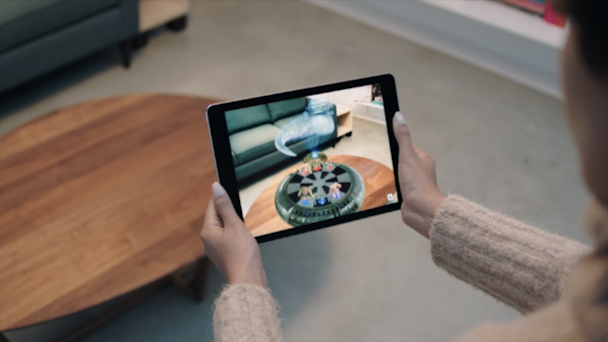Why 2018 will be the year of augmentation
In 2017, a standout trend was technology converging with physical fabrication to create a deeper brand experience for consumers. Humans learn and create memories through experience and interaction rather than passive consumption, so as a means of deepening their relationship with consumers, brands have learned the importance of creating enjoyable memories beyond the one-to-one consumer transaction and content play. The fabrication of custom physical products—whether sneakers, coffee stoppers or chips—augmented our content campaigns, breaking them out of the screens and into our targets’ homes and worlds.

Apple’s ARKit is helping bring augmented reality to the masses / Apple
In 2018, I hope and expect to see brands applying tech—such as machine learning, chatbots and AR—to facilitate ease of purchase or customer service while consumers simultaneously become comfortable with it showing up everywhere in their lives. Lufthansa’s travel assistant is a simple but great example. There will still be the impressive buzzworthy productions that use technologies in exciting ways, but I expect there will be a move away from using a technology purely for the sake of it--for example, the whimpering VR for the sake of VR trend of 2016--and more towards technology for solving problems.
Now, with the release of ARkit, ARCore, the integration of AR into social channels and WebAR just around the corner, augmented reality is in nearly every consumer's hands. And it makes the devices in everyone’s pockets that much more powerful for users who wish to explore a new communal, virtual space and how they can express themselves within it.
We are living in the future, and I would caution brands to be even more thoughtful as they take their first steps through and into it. The ubiquitousness of AR has deepened the discussion of our virtual world, as seen in the impressiveness of Snapchat’s augmented-reality partnership with Jeff Koons, “placing” his sculptures in public parks around the globe. That headline was quickly supplanted by news of graffiti artist Sebastian Errazuriz tagging the Balloon Dog placed in Central Park. This was not an artist making a statement against another artist, but rather a protest against the further commodification of public land—even if those public lands are virtual. Given the volume of advertising the general public is surrounded by in the physical world, brands need to be prepared for criticism regarding the visual pollution of virtual space.
This raises the question: how do brands respectfully navigate public spaces that are virtual? Intrinsic to concept development on any potentially augmented-reality engagement is a careful examination of the value exchange you are proposing to the consumer. Until WebVR is stable, AR projects are most commonly tied to an app for the user to download. Thus, the age-old UX problem arises: we’re asking consumers to take yet another step, consumers who’ve become exponentially savvier and more conservative with the amount of their data plan that they’re willing to spend on branded engagement. In a nutshell, consumers feel branded engagement had better be worth their time and enhance what they are doing or need to do.
Nexus Studios just launched a delightful navigation companion named Hotstepper that assists you within the often confusing world of mobile-map directions. The release was the result of internal experimentation aimed at showcasing their impressive development chops as well as their well-known character creation. Those of us who see how the sausage is made understand what an incredible feat this project is and, therefore, how pressworthy. But for everyday users, what they experience is what matters most: a charming character with valuable directional arrows who removes the stress of navigating from A to B.
Brands will need to learn quickly how to meaningfully integrate AR into their communications, engagement and customer-service offerings and ensure that their use of emerging technologies enriches customers’ lives or answers a need.
Tasha Cronin is co-director of interactive production for Droga5.
